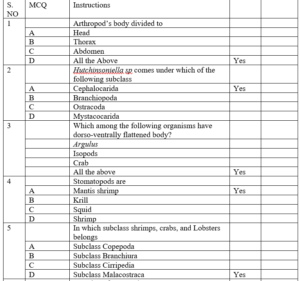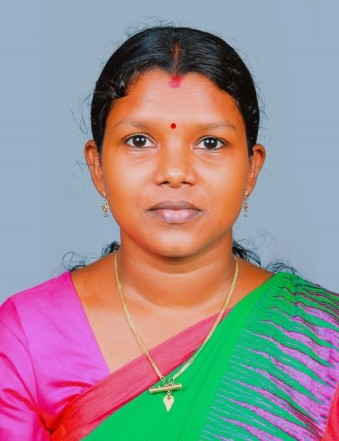Anatomy and Biology of shellfish
Course Attendees
Still no participant
Course Reviews
Still no reviews
Course Name : Anatomy and Biology of Shellfish
Code (Credit) :FSRM 3104 (1-1-0)
Program Outcome
PO1: Knowledge enhancement: Enhanced knowledge on concepts, essential facts, basics, principles and theories relating to fishery biology, biodiversity and aquatic environment, aquaculture, fish nutrition, fish physiology, genetics and biotechnology, fish processing, fisheries engineering, fish microbiology, fishery extension, economics, and biostatistics.
PO2: Professional and Entrepreneurial Skill development: Understanding the value and processes of life-long learning and professional enhancement and entrepreneurship development.
PO3: Critical thinking: After identifying the assumptions from the subject, take informed actions to frame the thinking and check out the degree to which these assumptions are accurate and valid, and look at our ideas and decisions (intellectual, organizational, and personal) from different perspectives.
PO4: Problem Solving: solve the problems from concerned disciplines using the knowledge, skills and attitude acquired from various disciplines in fisheries science.
PO5: Environment and Sustainability: Understand the issues of environmental contexts and sustainable development.
PO8: Team Work: Play effective roles in capture, culture, management, financial and marketing of fish produce.
Course Objectives
- To understand the internal and external anatomy of a shellfish in detail
- Knowledge on the various organs present, its functions and how they are functioning each other
- To study the life history event of shellfishes, which dealt with the food and feeding habits, age and growth, maturation and reproductive strategies followed by embryonic and larval development of shellfishes.
Course Outcome
| CO no. | Course outcome | POs / PSOs addressed |
| CO-1 | Understand the organismal form, living process and life history events of shellfishes. | PO1, PO2
PO3, PO4 PO5, PO8 |
| CO-2 | Determine the basic concept of food and feeding habits, age and growth to indicate the events in the life history of shellfish | PO1, PO2
PO3, PO4 PO5, PO8 |
| CO-3 | Explain the fundamental concepts of the physiological process of shellfish | PO1, PO2
PO3, PO4 PO5, PO8 |
Course Syllabus
Theory
Study of external and internal organization of commercially important crustaceans and molluscs. Digestive, respiratory, circulatory, nervous and reproductive systems. Food and feeding habits, growth, moulting, length – weight relationship. Reproductive biology, larval stages. Age and growth determination by direct and indirect methods.
Practicals
Study of Internal Organs commercially important crustaceans and mollusks. Study of Digestive, respiratory, circulatory, nervous and reproductive systems. Study of food and feeding habits - analysis of gut contents, age and growth, length - weight relationship and condition. Reproductive biology: maturity stages, spawning periodicity, fecundity and larval stages.
References
1.Text book of fish biology and Fisheries -S.S.Khanna and H.R.Singh
2.Physiology of Finfish and Shell fish -Kasturi Samantaray
Session Plan
Theory (16 Sessions)
Session 1: Study of the external and internal organization of Phylum Arthropoda and Mollusca
- General external morphology of phylum Arthropoda and phylum Mollusca.
- The internal organisation of phylum Arthropoda and phylum Mollusca
1. Anatomy_Phylum Arthropoda
Session 2: Study of the external and internal organization of Class Crustacea
- External morphology and general internal organisation of shrimp
- External morphology and general internal organisation of prawns
- External morphology and general internal organisation of crab
- External morphology and general internal organisation of lobsters
- 2.Morphology-Prawn or shrimp
- 3. Morphology-Crab
- 4.Morphology-Lobster
- https://www.youtube.com/watch?v=yAP-TWeAHyM
- https://www.youtube.com/watch?v=2cBGuEDxvNo
Session 3: Study of the external and internal organization of Class Gastropoda, Class Bivalvia, and Class Cephalopoda
- External morphology and general internal organisation of various gastropods, bivalves, squids, cuttlefish, and octopus
- 6.Class Bivalvia-Morphology
- 7.Class Gastropoda-Morphology
- 8.class cephalopoda
- https://www.youtube.com/watch?v=FRSggPhjVTo
- https://www.youtube.com/watch?v=IC4tZMrWrQI
Session 4: Digestive and nervous system of class crustacea
- Digestive tract, parts of gut, passage of food from mouth to anus in shrimp, prawn, crab and lobsters.
- Supraesophageal ganglion, nerve cord, connective ganglions in shrimp, prawn, crab and lobsters
Session 5: Digestive system and nervous system of class Gastropoda, and Bivalvia
- Digestive tract, parts of gut, passage of food from mouth to anus in gastropods, bivalves, and oysters.
- Ganglions and nerve cords running through various parts of the body in gastropods, bivalves, and oysters.
Session 6:Digestive system and nervous system of class Cephalopoda
- Digestive tract, parts of gut, passage of food from mouth to anus in squids, cuttlefish and octopus.
- Ganglions and nerve cords running through various parts of the body in squids, cuttlefish and octopus.
Session 7: Respiratory and circulatory system of class crustacea
- Gills: structure, types and position, Gas exchange.
- Heart: structure and position, blood circulation in shrimp, prawn, crab and lobsters.
Session 8: Respiratory and circulatory system of class Gastropoda, and Bivalvia
- Gills: structure, and position, Gas exchange.
- Heart: structure and position, blood circulation in Gastropods and bivalves.
Session 9: Respiratory and circulatory system of class Cephalopoda
- Gills: structure, and position, Gas exchange.
- Heart: structure and position, blood circulation in squid, cuttlefish and cephalopods
Session 10:Reproductive systems, growth and moulting- class crustacea
- Gonads: structure and positions in shrimps, crabs and lobsters.
- Moulting and growth of various commercially important crustaceans
Session 11 and 12: Reproductive systems class Gastropoda
- Gonads: structure and positions in organisms comes under the class gastropods
- Gonads: structure and positions in organisms come under the class Bivalvia
Session 13: Reproductive systems class Cephalopoda
- Gonads: structure and positions in organisms like squids, cuttlefish and octopus
Session 14: Food and feeding habits
- Major habits and habitats of commercially important shellfish and its feeding preferences. N
- iche it occupies and its distribution
Session 15: Length-weight relationship of commercially important shellfish
Session 16: Larval stages of shellfish and Age and Growth Determination of shellfish
Session Plan
Practical (16 Sessions)
Session 1: Study of external morphology of prawn
Session 2: Study of external morphology of shrimp
Session 3: Study of digestive system of shrimp
Session 4: Study of circulatory system of shrimp
Session 5: Study of excretory system of shrimp
Session 6: Study of nervous system of shrimp
Session 7: Study of reproductive system of shrimp
Session 8: Study of external morphology of Pila
Session 9: Study of external morphology of Unio sp.
Session 10: Study of external morphology of crab
Session 11: Study of digestive system of crab
Session 12: Study of reproductive system of crab
Session 13: Study of external morphology and internal anatomy of apple snail
Session 14: Study of external morphology of cephalopod
Session 15: Study of digestive system of cephalopod
Session 16: Study of reproductive system of cephalopod
E-material
Question Bank

Assignments
ABS-Assignment Topics
Course Outcome- Program Outcome mapping
| PO1 | PO2 | P03 | P04 | P05 | P06 | P07 | P08 | P09 | P010 | PO11 | P012 | PSO1 | PSO2 | PSO3 | PSO4 | |
| CO1 | 3 | 3 | 2 | 2 | 3 | 2 | 3 | 2 | 1 | 3 | ||||||
| CO2 | 3 | 3 | 2 | 2 | 3 | 2 | 3 | 2 | 1 | 3 | ||||||
| CO3 | 3 | 3 | 2 | 2 | 3 | 2 | 3 | 2 | 1 | 3 | ||||||
| Avg of CO-PO affinity levels | 3.00 | 3.00 | 2.00 | 2.00 | 3.00 | 2.00 | 3.00 | 2.00 | 1.00 | 3.00 |
Our Main Teachers

Saritha S is working as an Assistant Professor in the Department of Fisheries Resource Management, School of Fisheries, CUTM, Paralakhemundi Campus from May 2022 onwards. She completed her Ph.D. in Fisheries Resource Management from ICAR-Central Institute of Fisheries Education, Mumbai. M.F.Sc. (Master of Fisheries Science) in Fisheries Resource Management from the College of fisheries, Mangalore, and B.F.Sc. (Bachelor of Fisheries Science) from Kerala University of Fisheries and Ocean Studies, Kochi, Kerala. She qualified for ASRB ICAR-NET in Fisheries Resource Management discipline in 2016. she was Awarded UGC-Rajiv Gandhi National Fellowship for pursuing Ph.D. in 2014. Received University Gold Medal and H.P.C. Shetty Gold Medal for having secured the Highest Grade Point Average in Master of Fisheries Science in Fisheries Resources and Management for the Academic year 2013-14.
Assistant Professor, PhD School of Fisheries Centurion University of Technology and Management (CUTM) Paralakhemundi- 761211 Odisha, INDIA Mobile: +91 6238 514615 Email: [email protected] ACADEMIC QUALIFICATIONS Ph.D. in Fish Nutrition and Feed Technology(2020) from Central Institute of Fisheries Education(CIFE-ICAR), Mumbai M.F.Sc.(Master of Fisheries Science) in Fish Nutrition and Feed Technology (2015) from Central Institute […]

